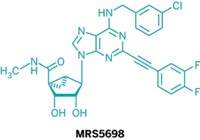Advertisement
Grab your lab coat. Let's get started
Welcome!
Welcome!
Create an account below to get 6 C&EN articles per month, receive newsletters and more - all free.
It seems this is your first time logging in online. Please enter the following information to continue.
As an ACS member you automatically get access to this site. All we need is few more details to create your reading experience.
Not you? Sign in with a different account.
Not you? Sign in with a different account.
ERROR 1
ERROR 1
ERROR 2
ERROR 2
ERROR 2
ERROR 2
ERROR 2
Password and Confirm password must match.
If you have an ACS member number, please enter it here so we can link this account to your membership. (optional)
ERROR 2
ACS values your privacy. By submitting your information, you are gaining access to C&EN and subscribing to our weekly newsletter. We use the information you provide to make your reading experience better, and we will never sell your data to third party members.
Biological Chemistry
Green mamba venom could treat kidney disorder
A protein in the snake’s poison blocks a receptor linked to polycystic kidney disease
by Sarah Everts
June 26, 2017
| A version of this story appeared in
Volume 95, Issue 26
A green mamba bite results in dizziness, nausea, difficulty breathing, irregular heartbeats, convulsions, and sometimes death. But the snake’s deadly venom contains a small peptide that could one day save lives. Researchers led by Christiane Mendre of the University of Montpellier, Ralph Witzgall of the University of Regensburg, Nicolas Gilles of Paris-Saclay University, and colleagues plucked a peptide out of the venom that might help people with polycystic kidney disease (Proc. Natl. Acad. Sci. USA 2017, DOI: 10.1073/pnas.1620454114). These individuals develop water-filled cysts on their kidneys that interfere with the organ’s function and can eventually be fatal. Treatment for the disease currently involves so-called vaptan drugs that interfere with a protein called the type 2 vasopressin receptor. But the drugs are toxic to another organ—the liver. The team of researchers noticed that a 57-residue peptide in the green mamba venom called mambaquaretin-1 also targets the receptor but is more selective than existing drugs. “With high selectivity and without toxic metabolic by-products associated with its peptidic nature, mambaquaretin-1 could become the preferential treatment for these disorders,” they note.




Join the conversation
Contact the reporter
Submit a Letter to the Editor for publication
Engage with us on Twitter